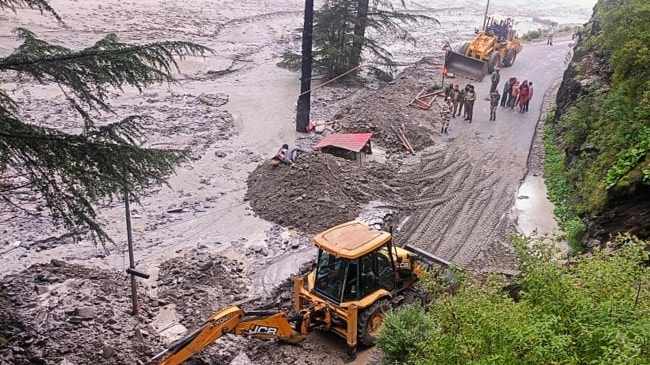Opinion Uttarkashi Cloudburst: What India should do to avoid further climate catastrophe
India must recognise that climate change is a systemic challenge requiring coordinated action at all local, national, and international levels
 An excavator clears debris from a road following flash floods near Harsil in Uttarkashi district on Wednesday. (Photo: PTI)
An excavator clears debris from a road following flash floods near Harsil in Uttarkashi district on Wednesday. (Photo: PTI) The recent tragic cloudburst in Uttarkashi, which devastated the village of Dharali and surrounding areas, is a stark reminder of how climate change is intensifying natural disasters in India. As heavy rains caused mountainsides to collapse and floodwaters to inundate homes, it became clear that our traditional infrastructure and disaster preparedness measures are woefully inadequate in the face of a rapidly changing climate.
This event is not isolated. Across the Hindu Kush Himalayan regions, we are witnessing an alarming increase in extreme weather phenomena — sudden cloudbursts, flash floods, landslides — that threaten lives, livelihoods, and ecosystems. What makes these incidents more devastating today is their increasing frequency and intensity, which scientific research links directly to the accelerated impacts of climate change.
The Himalayas, often called the “Water Tower of Asia,” are especially sensitive to climate shifts. Rising temperatures cause glaciers to melt and increase the amount of atmospheric moisture. Warmer air holds more water vapour — approximately 7 per cent more for every degree Celsius of warming. This extra moisture often results in intense, localised rainfall events, like cloudbursts, which are sudden, intense downpours over small areas. These events can dump significant amounts of water in minutes, causing floods, landslides, and destruction.
Recent studies have shown that cloudburst incidents in the Hindu Kush Himalayas have increased in frequency and intensity over the past few decades. The changing climate has destabilised weather patterns, making monsoon rains more erratic. Sometimes, the monsoon arrives late; other times, it unleashes a deluge. The terrain amplifies these effects, as steep slopes and loose soil make landslides more likely, while narrow valleys funnel floodwaters into villages, causing sudden and severe damage.
Despite the growing threat, India’s response to climate-induced disasters remains sluggish and fragmented. Traditional infrastructure — dams, drains, embankments — is designed for historical weather patterns and is often overwhelmed by the intensity of current events. There is a glaring lack of real-time monitoring infrastructure in the Himalayas and other vulnerable regions. Automatic Weather Stations (AWS), essential for capturing real-time data on temperature, rainfall, and atmospheric pressure in remote and high-altitude areas, are sparse.
Effective early warning systems are critical in saving lives and reducing damage during natural disasters. AWS and advanced meteorological models can provide real-time data that forecasts extreme weather events well in advance when fed into predictive algorithms. This allows authorities to issue timely alerts, evacuate vulnerable populations, and mobilise relief efforts before catastrophe strikes. International examples, such as Nepal’s pioneering use of early warning systems for mountain disasters, illustrate how technology can mitigate risks when integrated into a comprehensive disaster preparedness plan.
Instead of relying solely on grey infrastructure (such as dams and embankments), India must embrace ecological solutions — restoring wetlands, mangroves, and natural sponge zones that absorb floodwaters and reduce runoff. These nature-based solutions are cost-effective, sustainable, and adaptable to changing climate conditions.
In the mountains, land-use planning must prioritise the preservation of forests and natural buffers that minimise landslides and stabilise slopes. Reforestation and afforestation programs should be expanded, especially in areas prone to erosion. These measures increase the resilience of local ecosystems and communities, helping them withstand climate change shocks.
Governments must also mainstream climate adaptation into urban planning, infrastructure development, and disaster response strategies. This means allocating dedicated funds for climate risk assessments, investing in resilient infrastructure, and empowering local communities with knowledge and resources.
Community-based disaster management should be prioritised, particularly in vulnerable rural and hill areas. Residents often possess valuable traditional knowledge about weather patterns and natural warning signs, which can be integrated into official early warning systems for more effective responses.
Uttarkashi: What is to be done?
Firstly, expanding and modernising our weather monitoring infrastructure, especially in the Himalayas and fragile mountain regions, is essential. Establishing more Automatic Weather Stations (AWS) and utilising satellite-based observation systems can provide real-time data critical for early warnings.
Secondly, integrating ecological solutions into broader infrastructure planning is vital. Thirdly, climate change adaptation must be embedded within policy frameworks. This involves mainstreaming climate resilience into urban and rural planning, incentivising community participation, and ensuring that marginalised groups near drainage channels and other vulnerable zones receive special attention during rehabilitation efforts.
Finally, India must recognise that climate change is a systemic challenge requiring coordinated action at all local, national, and international levels. Investing in research, fostering innovation in climate resilience technologies, and partnering with regional neighbours can bolster adaptive capacity across the Himalayas and beyond.
The writer is a Clinical Associate Professor (Research) and Research Director at Bharti Institute of Public Policy, Indian School of Business (ISB)





